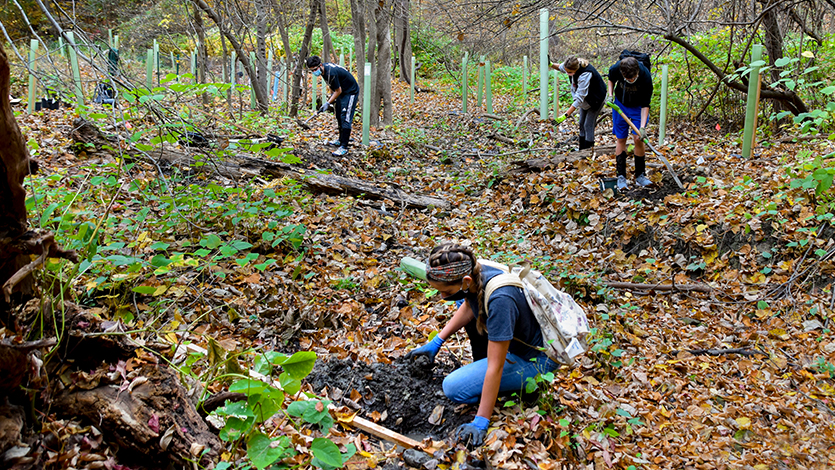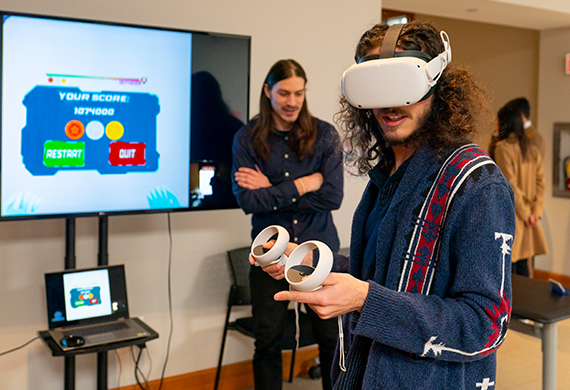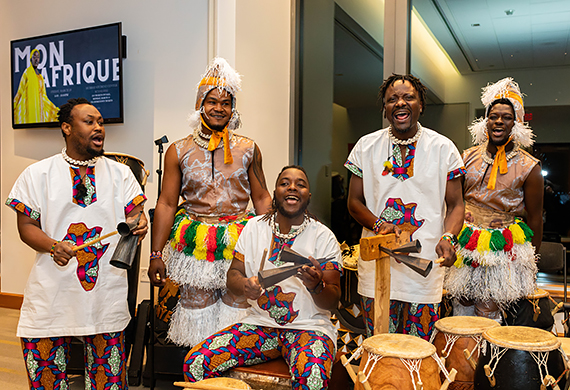Branching Out

Students and volunteers plant native species in Marist’s Fern Tor Nature Preserve, supported by a New York State conservation program to improve stream ecology.
February 4, 2021—Autumn in New York’s Hudson Valley is prime time for leaf-peeping. This past October, Marist students and volunteers went into the woods for another reason: to plant trees and shrubs that will help conserve a tributary.
The College acquired the preserve, 13 acres of woods known as Fern Tor, in 1997. The property, at the north end of the campus, has a Hudson River view and is open to the campus community. Dr. Richard Feldman, chair of Marist’s Department of Environmental Science and Policy, and colleagues use it as an ecology lab. He also has been looking out for the well-being of the preserve.
“My overall goal is to reestablish native plant species,” said Feldman. But first he needed to control an invasive species called Japanese knotweed that was engulfing the preserve. Those efforts have succeeded, primarily because of repeated cutting of the knotweed by Feldman and his students. At one point, goats were also brought in to eat the knotweed.
That has set the stage for reintroduction of other species, said Feldman. A New York State program called Hudson Estuary Trees for Tribs is the latest part of that endeavor. The state’s Department of Environmental Conservation (NYSDEC) gives organizations native trees, shrubs, and grasses at no charge to plant along tributaries and thereby keep waterways healthy. These streamside buffers help reduce water pollution, decrease erosion and flood damage, and provide habitat for fish and other wildlife.

Dr. Richard Feldman, chair of Marist’s Department of Environmental Science and Policy, leads students and volunteers in a New York State-funded program called Hudson Estuary Trees for Tribs.
“Increasing plant species diversity will attract insects and birds,” said Feldman. “There are important ecological relationships depending on that. It’s all about trying to enhance the overall biological diversity of the region.”
This fall Feldman asked two environmental science majors, Gabriel Mongeau ’21 and Hartley Walker Money ’21, to lead the Trees for Tribs project at Marist during the fall 2020 semester. Their role was to take the NYSDEC’s recommendations for each plant species and decide where each species should be planted in Fern Tor. Thirteen were selected: silver maple, smooth alder, buttonbush, silky dogwood, flowering dogwood, red-osier dogwood, swamp rose, pussy willow, American black elderberry, black gum, arrowwood viburnum, nannyberry, and cranberry bush.
“We also put a lot of effort into organizing the volunteers and supervising them,” said Mongeau. They coordinated 18 volunteers as well as 9 students from one of Feldman’s classes and taught them how to plant the saplings.
Mongeau spent 10 hours a week for three weeks during October during the most demanding part of the project. “This was my first time leading a project of this size with this many people, so it was pretty daunting at first,” he said, “but I think the biggest challenge was doing this during COVID-19. The project was a success, though, thanks to everyone being responsible and following the guidelines.”

Left photo: Mongeau tagging. Right photo: Mongeau (standing) and Money (crouched) plant saplings.
Feldman said the pandemic may be the reason he noticed more students than usual in Fern Tor throughout the semester. Although COVID-19 meant most social and recreational activities on campus were canceled, students could still enjoy the serenity and beauty of the preserve.
“My sense is that they felt itchy to get out,” said Feldman. “And the weather was good this fall.”
The virus also curtailed all environmental science field trips, Feldman said. So he and fellow professors brought their classes to Fern Tor instead.
Mongeau, who plans to work in conservation science after graduating, said the project helped him realize how much environmental work there is to be done. “But I’m excited for it.”
“I enjoyed knowing I was doing something that was helping the environment, and I was very happy to have shared that experience with my peers.”



